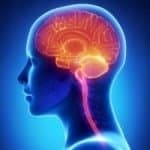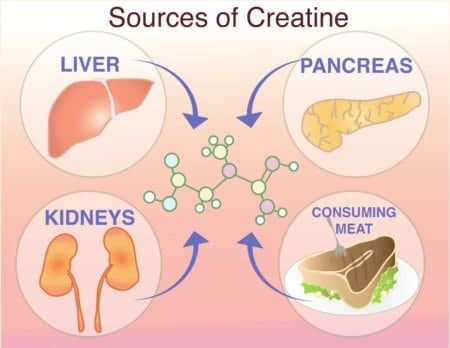
What is Creatine? Creatine (α-methyl guanidine-acetic acid) is a substance that is found naturally in muscle cells. It is a dietary supplement that improves exercise performance and increases fat-free mass (R). Creatine is a compound that is both made inside the body from amino acids and obtained through diet (R). About 95% of the body’s creatine is stored in skeletal muscles, in the form of phosphocreatine. The other 5% are stored in the brain, kidney and liver (R).
|
Energy—8.5/10 Brain Function–8.5/10 Strength—–9.0/10
Cognition—-8.0/10
|
Pros Increases muscle mass and strength Improves mental health Reduces exercise-induced fatigue Cons Causes water retention which may cause weight gain. |
Phosphagen System
2) Creatine Increases Strength And Exercise Performance
Creatine supplementation has been reported to increase body mass and improve performance in high-intensity, short duration exercise tasks (R1, R2). Using this supplement in combination with strength training amplifies the increase in muscle cell nuclei concentration, thereby increasing the growth of adult skeletal muscle in healthy male subjects (R). Supplementation enhanced free-fat mass, physical performance, and muscle morphology in response to heavy resistance training (R). Elevated levels of the protein myostatin are well known for slowing or totally inhibiting new muscle growth. Supplementation of creatine reduced these levels, increasing growth potential in healthy male subjects (R). 
3) Creatine Improves Brain Performance 
Oral creatine monohydrate supplementation in young adult vegetarian subjects had a positive effect on both working memory and intelligence (R1, R2). Supplementation in elderly people improved their cognitive performance in one study (R). In one study following 36 hr sleep deprivation, supplemented individuals demonstrated improved performance on a random number generation task (R). Creatine supplements for older adults can improve the quality of life and may reduce the disease burden associated with sarcopenia and cognitive dysfunction (R).
4) Creatine May Help Against Parkinson’s Disease
In one study, creatine monohydrate supplementation in patients with Parkinson’s Disease improved upper body strength and could enhance the benefits of resistance training (R). Combination therapy with Coenzyme Q 10 could delay the decline of cognitive function in PD-MCI (Parkinson’s Disease-Mild Cognitive Impairment) patients and could lower their plasma Phospholipid levels (R). Creatine has been shown to have beneficial effects on Parkinson’s in mice, preventing 90% of the drop in dopamine levels which characterize Parkinson’s (R). However, more well-designed clinical trials with a larger sample size and long-term follow-up are needed to assess the use of creatine for Parkinson’s Disease.
5) Creatine Can Fight Other Neurological Diseases 
Oral supplementation of creatine which is a substrate for creatine kinase, may increase Phosphocreatine (PCr) and buffer against ATP depletion and thereby exert neuroprotective effects (R). Daily creatine supplementation helps decrease depression symptoms in women suffering from Major Depressive Disorder. These women did not respond to SSRI treatment, so this supplement might be a good alternative to help treat depression (R). 8-hydroxy-2-deoxyguanosine, a marker for damaged DNA, was abnormally high in patients with Huntington’s disease, but creatine treatment reduced this marker (R). Oral creatine supplementation provided improvements in lifespan, muscle strength or motor unit numbers in patients with Amyotrophic lateral sclerosis, a disease that affects brain cells and the spinal cord (R1, R2). Creatine supplements help treat other diseases like Alzheimer’s’, Ischemic stroke, epilepsy, brain or spinal cord injuries in animal models (R1, R2, R3, R4).
6) Creatine May Reduce Fatigue
A five-day dose of creatine in women may be an effective strategy for delaying the onset of neuromuscular fatigue (R). Creatine supplementation had reduced ratings of perceived leg fatigue in endurance-trained males who performed exercises in heat (R). Following 24-h sleep deprivation, creatine supplementation had a positive effect on mood state and tasks that place a heavy stress on the prefrontal cortex (R).
7) Creatine Protects the Heart
In mice, it helped protect the heart after stress and increase repair activity (R). Creation of creatine also lowers homocysteine levels. Homocysteine can increase the risk for heart disease, so lowering homocysteine can help with cardiovascular protection (R). Daily, 20g doses can lower cholesterol by 5%, lowering risk for heart attacks or other problems (R). 8) Creatine May Lower Blood Sugar Levels And Diabetes Creatine demonstrated a significant decrease in OGTT (Oral glucose tolerance test) area under the curve compared to the placebo in healthy male subjects undergoing aerobic training (R). Creatine supplementation is a possible nutritional therapy adjuvant with lowering blood sugar effects, particularly when used in conjunction with exercise (R).
Creatine supplementation without associated training in the elderly could potentially delay atrophy of muscle mass, improve endurance and strength, and increase bone strength (R). Supplementation, when combined with resistance training, increased lean tissue mass and improved leg strength, endurance, and average power in men around 70 years old (R1, R2 ). ..Aha !! …I knew it!! Long-term supplementation combined with resistance training improves the ability to perform functional tasks and promotes a greater increase in maximal strength, fat-free mass, and muscle mass in older women (R).
10) Creatine Improves Bone Health
Bone growth factors work with creatine to increase osteoblast formation, which helps increase bone formation and bone repair (R). Daily doses of creatine also reduced pain and symptoms of osteoarthritis in older women (R).
11) Creatine Aids in Pregnancy 
Creatine supplementation during pregnancy may have benefits for the fetus in cases of fetal growth restriction, premature birth, or when childbirth is delayed or complicated by oxygen deprivation of the newborn (R). Creatine loading before birth significantly protects the diaphragm from hypoxia-induced damage at birth (R). Increasing maternal dietary creatine consumption could be a useful treatment for preventing a lack of oxygen in newborns (R). 12) Creatine May Help Against Non-Alcoholic Fatty Liver Disease -Supplementation is known to reduce fat accumulation, resulting in beneficial effects in fatty liver and non-alcoholic liver disease (R). Creatine prevents liver steatosis and lipid peroxidation in rats fed a high-fat diet. There was also a reduction in the accumulation of lipids in the liver cells (R).
Technical Section
-
Cr kinase enzymes regulate ATP homeostasis in subcellular compartments by the transfer of phosphates between creatine and adenine nucleotides (R).
-
The CrK system is regulated by AMP-activated protein kinase via Pcr/Cr and ATP/AMP ratios (R).
-
Creatine regulates the differentiation of mesenchymal stem cells (MSCs) in processes such as osteogenesis and myogenesis (R).
-
Creatine enhances differentiation of myogenic C2C12 cells by activating both p38 and Akt/PKB pathways (R).
-
Cr feeding to mice skeletal muscle enhances the nuclear content and DNA binding activity with an increase in GLUT4 gene expression (R).
-
Catecholamines, insulin-like growth factor 1 (IGF-1), insulin, and exercise can influence the net uptake of Creatine into skeletal muscle (R).
-
Creatine may also have important modulatory effects on the glutamate and GABA-A receptor systems that raise the threshold for the onset of excitotoxicity in the brain (R).
-
Sources creatine. It is found in the liver, pancreas, and kidneys (R) and in various types of food:
-
Beef (R)
-
Chicken (R)
-
Rabbit (R) Milk (R)
-
-
Side Effects
-
Weight Increase (R)
-
Cramps (R)
-
Digestive Problems (R)
-
Dosage Short-term supplementation (e.g. 20 g/day for 5-7 days) increases total content by 10-30% and phosphocreatine stores by 10-40% depending on you and your current levels (R). A loading protocol is the fastest way to maximize muscle creatine stores. It involves taking a high dose for a few days, and then a lower maintenance dose after that (R). This usually means 20-25 grams of creatine per day, split into 5-gram doses, for 5-7 days. Then this is followed by a maintenance dose of 3-5 grams per day (R). I take 1-2g a day.
Article thanks to → Joseph Cohen 





